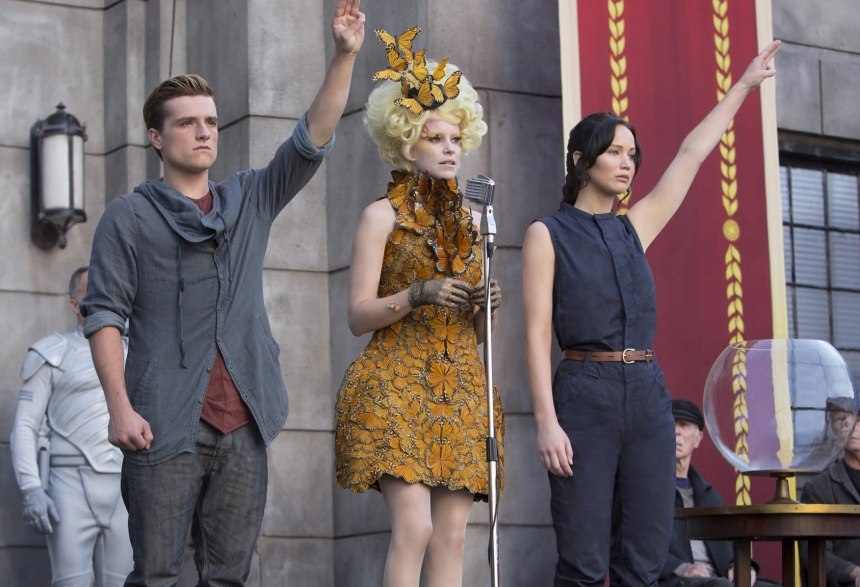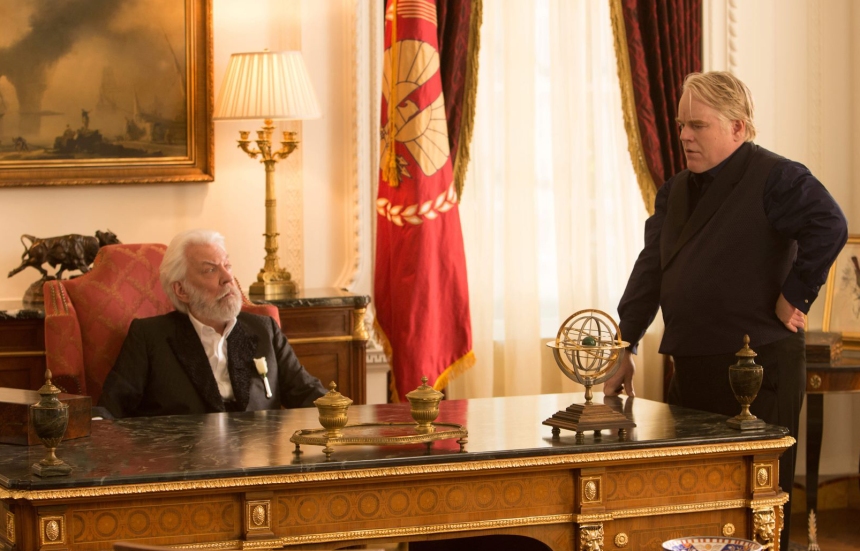The Hunger Games: Catching Fire Review

THE GIRL ON FIRE RETURNS
Since the first book debuted back in 2008, Suzanne Collins’s The Hunger Games series has captivated readers across the world, both young and old, and skyrocketed to being a world bestseller. With its popularity solidified, it was a foregone conclusion by many fans (Yet slightly risky by movie studios) to adapt the book series into movie franchise. Thus, in 2009, Lionsgate Entertainment acquired the rights to the series and by 2012 The Hunger Games, the first book in the three-part trilogy, debuted to audiences on the silver screen. The film did have its critics, but ultimately won over many fans and moviegoers, cashing big at the box office ($691 Million worldwide) and the start of a promising movie franchise. Now, a year and half later, Lionsgate Entertainment moves forward with the next film chapter titled The Hunger Games: Catching Fire. With a new director helming the project and with expectations set high for its debut, does second film of this celebrated dystopian saga live up to the hype it’s been credited or does it fail to make the jump from page to screen?

THE STORY
Roughly a year after the events of the first film, Katniss Everdeen (Jennifer Lawrence) and Peeta Mellark (Josh Hutcherson), the two winners of the 74th Hunger Games, are sent on the “Victory Tour” and touring across the nation of Panem to promote mortality, but baring witness to the grim reality that permeates majority of the 12 Districts. Yet, while the pair is being promoted as “Star Crossed Lovers” to the public on their tour, Katniss’s heart is still torn between Peeta and long-time friend Gale (Liam Hemsworth); an action which draws ire to Panem’s ruler President Snow (Donald Sutherland). Snow begins to realize the potential threat that Katniss poses and comes to the conclusion that she must be eliminated in a discreet and public way. With the help of the new Gameskeeper Plutarch Heavensbee (Phillip Seymour Hoffman), Snow declares that the 75th Hunger Games (Also known as the Quarter Quell) will be bring back past game victors (Including Katniss) in a sort of All-Star Hunger Games event. Katniss Everdeen survived the games once before, but with new challenges, new dangers, and harder adversaries than before, will she survived the “Quarter Quell”?

THE GOOD / THE BAD
As I continue to write new movie reviews, I look back to my some of my old reviews from my old movie blog (before I switched to WordPress). So I’m deciding to dust some of them off from time to time (tweaking some of the wordage) and reposting them on Jason Movie Blog, which brings me to this post. Since I worked at bookstore, I saw the mass popularity swell with Collins’s Hunger Games books (yes I read the books) as well as watching the film adaptation of The Hunger Games. Like many, I thought it was good (a couple of problems along the way), but it still had a promising start to a movie franchise. My anticipation for seeing its sequel (Catching Fire) was building as the hype for it was indeed palpable with public and with myself. After viewing it, I thought that The Hunger Games: Catching Fire had some minor problems, but was indeed better than its predecessor.
With the success of the film The Hunger Games, many wonder if that its director Gary Ross would return to direct Catching Fire. Unfortunately, Ross bowed out of the role and Francis Lawrence, who previously directed such films as I Am Legend, Constantine, and Water for Elephants) took over as director for the follow-up sequel and what an amazing job he’s done. Rather than reimagining the world for his movie, Lawrence took what Ross establish in the first film and built upon it (most notably leaving intact the set and costume designs). Lawrence also seems to learn from Ross’s mistake he made on the first film on what works and what doesn’t and creates a more tightly woven story with a clearer sense of the film’s direction that feels neither relatively short nor overly bloated.
What adds to that is the fact the Catching Fire’s script (Penned by Simon Beaufoy and Michael Amdt) is more faithfully to the book than the first film was as audiences will pretty much get what Suzanne Collin’s envisioned in her book on the big screen, which fans of the books will enjoy immensely. The visuals effects have also improved, giving more detailed and richness to the movie’s locales and the game’s action sequences.

Speaking of the games themselves, the shaky camera movement that plagued the previous film, which was heavily criticized, is used very little and is pretty much non-existent. Also the carnage from the first film during the games, which was used for a “shock and Awe” tactic, is still there, but really downplayed as Lawrence decides to focus more on the environmental challenges and obstacles that Plutarch Heavensbee sets before them (poisonous Fog, vicious monkeys, etc.) rather than the brutal and savage combat from the game’s contestants.
The major pitfall with most trilogies (books, films, video games, etc.) is that the middle tale is the hardest to pull off. The first installment introduces the setting, it characters, and the overall conflict of the narrative, while the third installment respectfully resolves the main conflict, thus bringing an end to the story. The second installment is tricky, often the bane to writers serving as neither beginning nor end, but rather as a continuation that usually gains the least favored praise by viewers. The Hunger Games: Catching Fire is one such example. With the exception of the first 40 minutes of the film, majority of the film is sort of “Déjà vu”, playing out most plot points and progression from that of the first film. However, this derives from the book’s source material of from which it was adapted from and was crucial to the book’s overall structure, so it really couldn’t be changed. Nevertheless, the film still does have that “been there, done that” feel and be might cited it as a “turn off” by some viewers (It was a little for me.
In addition, while I did enjoy the movie more so than the first one, Catching Fire runs a bit long. I know it’s only a 4-minute difference between this and The Hunger Games, but does feel long, especially when it actually comes to the “game” event of the Quarter Quell. Then there was the film’s cliffhanger ending. Yes, it’s a very abrupt one and is faithfully to where the book ends as well, but it comes with much frustration as the movie seems to be building momentum up to this point. Perhaps a scene or two should’ve been added to the final cut of the movie, offering a little more satisfying closure to Catching Fire’s ending. But as they say in show business “Leave them wanting more” as most moviegoers will be (whether they like it or not).

Majority of the cast from first movie returns to their post in Catching Fire, bringing their own level of degree of charisma and tenacity to their character. Leading the charge is Jennifer Lawrence, now an Oscar winner, whose performance brings this fantastical movie down to a very “Human” level, dealing with issues of PTSD, living with the pretense of a false love, and the overwhelming pressure of being a poster child, whether good or bad. Behind Lawrence’s Katniss is Josh Hutcherson’s Peeta Mellark, who like Lawrence, returns to the character and plays it well. Hutcherson’s is still invested in the role, adding a layer persona to Peeta, showcasing his desire love for Katniss (who continues to be torn between him and Gale) as well as his savviness throughout the Quarter Quell.
Along with Lawrence and Hutcheson, are the plethora of supporting characters, including Liam Hemsworth’s Gale (who has a bit more to do than his very brief stint in the first film), Elizabeth Banks as the flashy / gaudy dresser Effie Trinket, Woody Harrelson as the partly sober mentor Haymitch, Willow Shields as Katniss’s sister Primrose, Lenny Kravtiz as Katniss’s Capitol stylist Cinna, and Stanley Tucci as the Capitol’s TV show host Caesar Flickerman. It’s also worth noting that Donald Sutherland’s President Snow (the overseeing dictator of Panem / antagonist of the series) gets a bit more screen time, showcasing his polite-like villainy to all and his multiplicative dealings with his new Gamekeeper Plutarch Heavensbee, played by actor Phillip Seymour Hoffman (who does a great job in the role). All these characters deliver good performances (despite minor / supporting roles) and do bring a state of familiarity to the movie’s proceedings.
Much like how it was with the first movie, most of the other tributes chosen for The Hunger Games don’t get that much camera time with his or her own back-story. However, this time around, a few more get expanded upon during the course of the feature, most notably in Sam Claflin’s narcissist character of Finnick Odair, whose motives and intentions are unclear; hidden beneath his snarky bravado. Other candidates worthy mention Lynn Cohen’s as the elderly muted Mags, Amanda Plummer and Jeffery Wright as the quirky duo of Wiress and Beetee, and Jena Malone as the incorrigible presences of Johanna.

FINAL THOUGHTS
Katniss and friends return to the Capitol’s arena for the celebratory Hunger Games (The Quarter Quell) in the movie The Hunger Games: Catching Fire. Director Francis Lawrence’s movie of the popular novel series continues the story from the previous movie, building upon the exciting tale of Katniss Everdeen and the dystopian world of Panem. Despite its own drawbacks with its plot structure being vaguely familiar to its predecessor, The Hunger Games: Catching Fire delivers a strong and overall worthy successor to a confident movie series franchise. To me, with a more refined script for the narrative, a stellar cast, improved visuals, and a new director, Catching Fire is indeed an entertaining and thrilling cinematic adventure, a definite “must see” for fans of Collin’s novels and of dystopian features. The “girl on fire” is back and better than ever.
4.3 Out of 5 (Highly Recommended)
Released On: November 22nd, 2013
Reviewed On: November 23rd, 2013
The Hunger Games: Catching Fire is rated PG-13 for intense sequences of violence and action, some frightening images, thematic elements, a suggestive situation and language

From someone who isn’t very big on the YA genre, I thought Catching Fire was a pretty good action film, with some spectacular set pieces at points. That doesn’t take away from the fact that Josh Hutcherson spent a segment of the film crying in a cave! Nice review!
Milo.
Haha…true. I agree with you on Hutcherson.
I loved both this book and movie, really liked being introduced to Finnick as well!!
Oh yes. The book was probably my least favorite of the trilogy, but it was the best of the movies. That’s what I think.
Oh that’s interesting, but glad you liked the movie though!
Great detailed review. I really liked this film, I thought Catching fire was easily the best in the series. I wasn’t much of a fan of the last two in the franchise. And I accidentally posted above without finishing my sentence haha. Not sure if I can delete it?
Haha…its okay (I deleted the first one). I loved Catching Fire. I thought it was the best of the four movies.